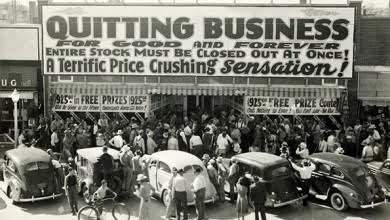By Adam Blair, Executive Editor

Many explanations have been floated for the recent challenges faced by brick-and-mortar retailers, particularly department stores. The usual suspects include: competition from e-Commerce (even though most department stores also are omnichannel operations); the lingering effects of the recession; and fast fashion and discount/outlet retailers cutting into these stores’ traditional traffic generators, apparel and footwear.
There’s also a simpler, though possibly more disturbing, idea floating around: that there are just too many brick-and-mortar stores operating in the U.S. today.
A recent study from real estate research firm Green Street Advisors concluded that in order for department stores to regain the productivity levels they enjoyed a decade ago, they would need to shutter approximately 800 locations, or 20% of the anchor space in retail malls, as reported in the Wall Street Journal.
To take the most drastic examples, JCPenney would need to close 320 stores, while Sears would need to turn off the lights at 300 sites. Last year, the department store sector averaged sales of $124 per square foot, a 24% decline from 2006. Between 2006 and 2016, department stores shrank their physical footprint by 7%.
From the general to the specific: Last week, a Deutsche Bank analyst said that even though Gap already has been closing stores, the retailer will still have a 175-store surplus by the end of this year. So rather than its 828-store fleet, this analyst believes Gap should operate only 375 stores, according to Fortune.
Does The Herd Really Need To Be Culled?
You can argue over the specific numbers, but there is a certain logic to the overall concept. E-Commerce and particularly mobile commerce have become undeniable facts of retail life. While stores continue to play vital roles in the shopping journey, there’s little question that a certain percentage of shoppers simply see no need to visit a brick-and-mortar location for the bulk of their purchases. The rise of digital native generations, Millennials and their younger Gen Z counterparts, means there will be even more consumers who lack a “brick-and-mortar shopping gene” as part of their consumer DNA.
The next question is, would a more sparsely populated retail landscape necessarily be a bad thing? There’s a certain Darwinian logic to a retailer operating fewer but more profitable stores. In the short term, there would be destructive economic ripples if mall after mall lost its anchor stores. There’s the human cost as well, with store employees losing their jobs and the retail organizations losing the combined experience and human intellectual capital contained in the heads of managers and support staff.
Of course, no one is suggesting that retailers keep underperforming brick-and-mortar stores open simply to ensure job security for workers, or to keep ailing malls on life support. But it seems to me that we’re asking the wrong questions by focusing simply on raw numbers. It’s not how many stores a retailer operates, but what functions those stores fulfill. Department stores don’t have to be the same-old places they’ve always been. For example:
• Stores can slim down their inventory holdings and refashion themselves as experience centers, providing the sights, sounds, and smells that can’t be replicated online;
• Stores can become more flexible, using technology to learn more about shoppers and provide them with products they don’t even know they need yet; and
• Stores can operate as a fulfillment network, making ship-from-store and click-and-collect offerings not just practical but profitable.
Finally, it seems more than a bit disingenuous for Wall Street to be a cheerleader for store closures. For every analyst saying the landscape is overstored, there are a dozen who will label news of actual store closings as an unmistakable sign that the retailer is in dire straits. Truth be told, it’s a tough mindset to get out of, and we in the media also need to examine store closings with a more neutral eye. As with anything else in the real world, sometimes less is more, and sometimes less is less.






